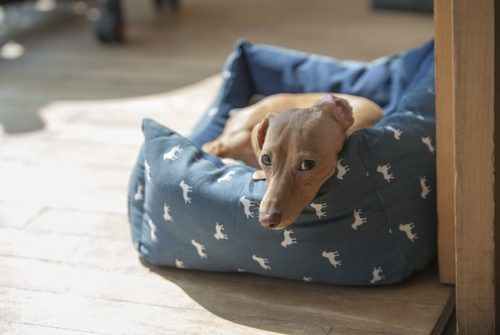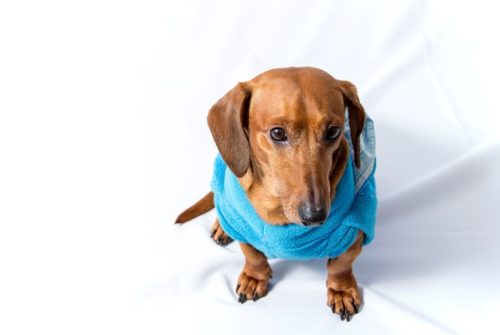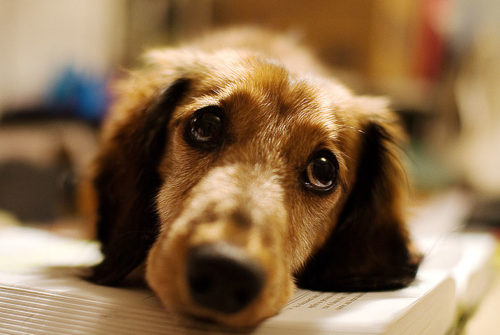
Dachshunds completely and totally rule when it comes to colors and coat patterns… they come in more color/coat varieties than any other breed of dog!
Colors
All dachshunds have a base color, often referred to as the self color. The self color can be one solid color (red, for example), or two (such as black and tan). Some dachshunds will also have a coat pattern, which are discussed in the Patterns section further down. Coat patterns, if present, are superimposed onto the self color base. Onto the colors!
Red

OK, red dachshunds aren’t really red, but rather brown with a hue of red mixed in. Red dachshunds can range in color from a light golden red, to a deeper, darker mahogany-like color. While they are typically a solid red color, they can sometimes have black shading, referred to as an overlay, around the ears, tail, or along the back. The black overlay is more common in the long-haired varieties. Often, a black hair overlay that is visible in puppyhood will fade as the puppy gets older. Red dachshunds will usually have brown eyes, with a black nose and black nails, but occasionally they can have greenish-brown (hazel) eyes, with a brown nose and brown nails (sometimes referred to as liver-colored). Red dachshunds are the most common and most familiar of the dachshund colors.
Black
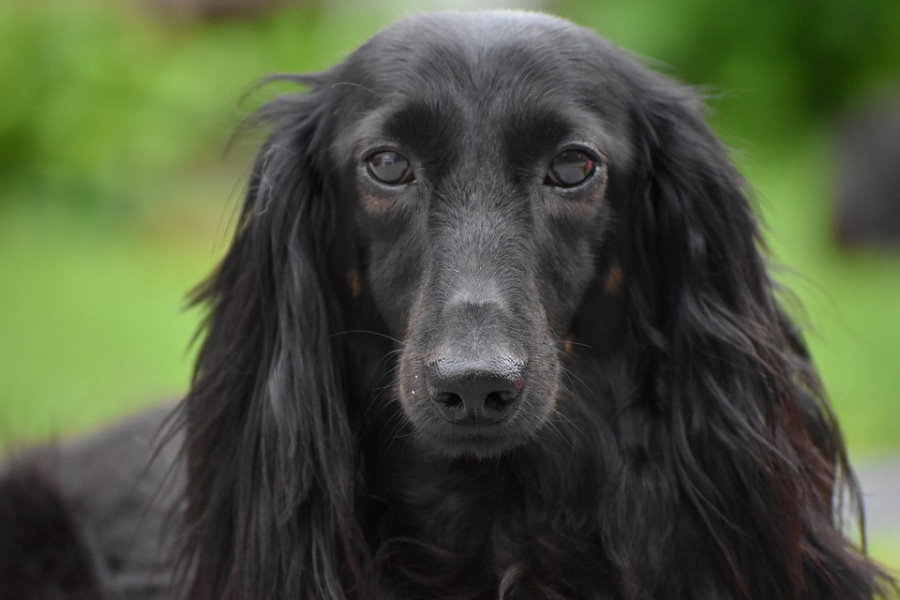
The black dachshund has a shiny solid black colored coat with no tan or cream colored points. They will have dark brown eyes, a black nose, and black nails.
Black and Tan
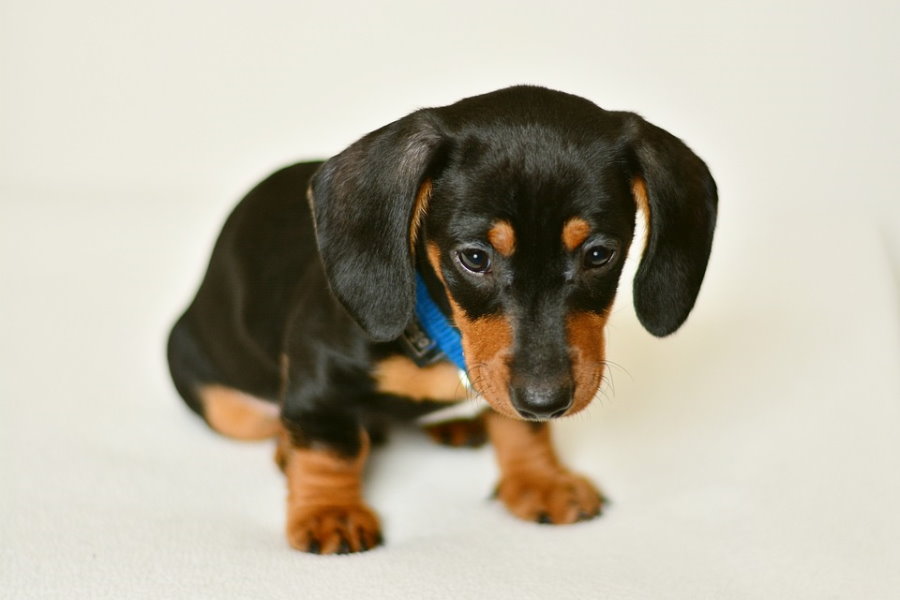
The second most popular dachshund color is the black and tan. A black and tan dachshund is mostly black with tan points above the eyes, around the nose/muzzle, on their feet, chest, and under the tail. The tan coloring is the same shade as that of the red dachshund. They will have dark brown eyes, a black nose, and black nails.
Black and Cream
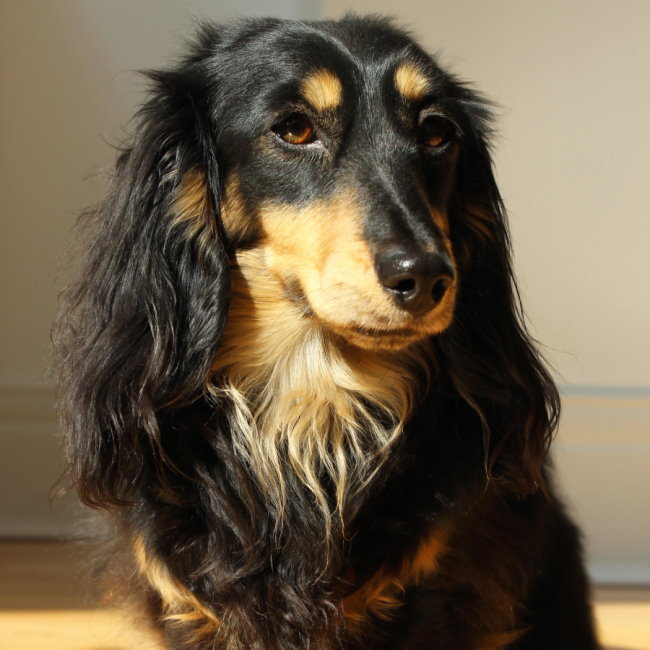
The black and cream dachshund is mostly black with cream points above the eyes, around the nose/muzzle, on their feet, chest, and under the tail. The cream coloring is buttery-yellow, with no hint of red. They will have dark brown eyes, a black nose, and black nails.
Blue
The Blue dachshund is a dilution of the black dachshund. They have a rich gray color, which some have described as a gunmetal blue, or a steel gray. They will have gray eyes, a gray nose, and gray nails. The solid blue dachshund has no tan or cream colored points.
Blue and Tan
The blue and tan dachshund is mostly blue with tan points above the eyes, around the nose/muzzle, on their feet, chest, and under the tail. The tan coloring is the same shade as that of the red dachshund. They will have gray eyes, a gray nose, and gray nails.
Blue and Cream
The blue and cream dachshund is mostly blue with cream colored points above the eyes, around the nose/muzzle, on their feet, chest, and under the tail. The cream coloring is a light buttery-yellow, with no hint of red. They will have gray eyes, a gray nose, and gray nails.
Chocolate
The chocolate dachshund will have a solid dark chocolate-brown coat without any tan or cream colored markings. They will have brown to light brown eyes, a brown nose, and brown nails. A true chocolate dachshund will never have any black hairs, black nails, or a black nose.
Chocolate and Tan Dachshund
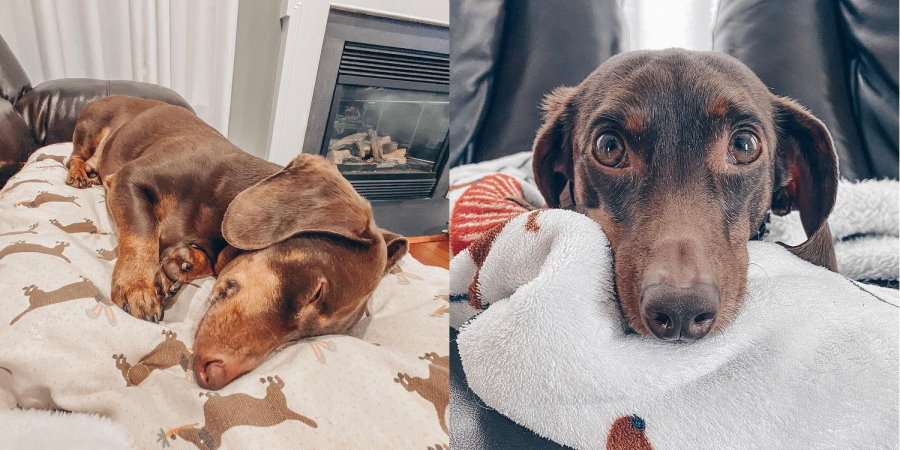
The chocolate and tan dachshund is mostly a dark chocolate-brown color with tan points above the eyes, around the nose/muzzle, on their feet, chest, and under the tail. The tan coloring is the same shade as that of the red dachshund. They will usually have dark brown eyes, but can also have a lighter hazel color. A brown (liver-colored) nose, and brown (liver-colored) nails are usual, but it is possible for them to have a lighter brown nose and nails. Lighter eye, nose, or nail colors are a sign that dilution factors are present.
See more of WinstonTheDox on his Instagram account.
Chocolate and Cream
The chocolate and cream dachshund is mostly a dark chocolate-brown color with cream colored points above the eyes, around the nose/muzzle, on their feet, chest, and under the tail. The cream coloring is a light buttery-yellow, with no hint of red. They will usually have dark brown eyes, but can also have a lighter hazel color. A brown (liver-colored) nose, and brown (liver-colored) nails are usual, but it is possible for them to have a lighter brown nose and nails. Lighter eye, nose, or nail colors are a sign that dilution factors are present.
Cream
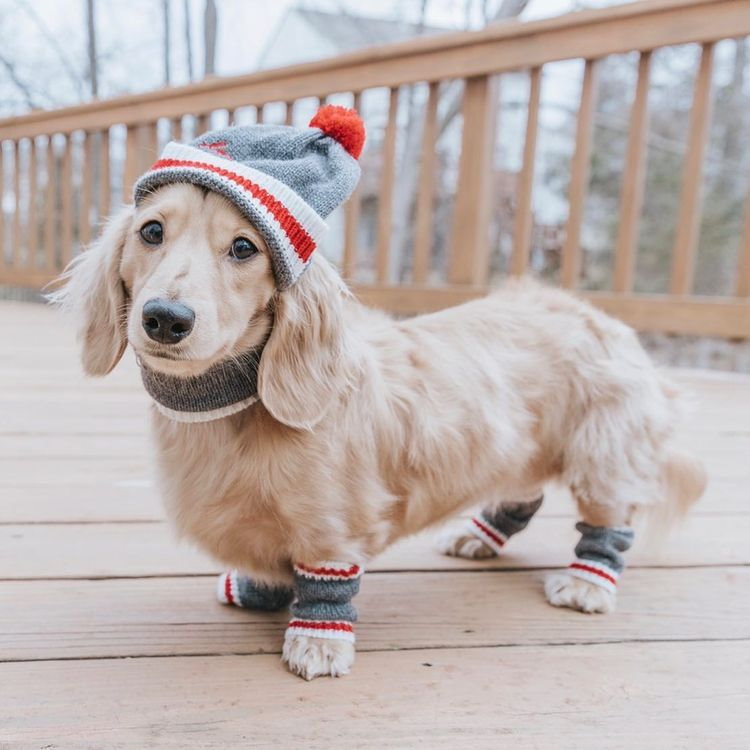
The cream colored dachshund has a solid, beautiful, light to golden blond coat, with no hint of red. True cream colored dachshunds will have dark eye-rims, and dark colored eyes. The nose will be black, and nails can be either black, or brown. If there is a brown (liver-colored) nose, or a even a slight hue of red in the coat, it is not a true cream. English Cream and American Cream dachshunds are terms you will hear to describe the various cream-colored dachshunds, but there are really no such official colors. Generally, the English Cream dachshund is referring to a cream-colored dachshund of British ancestry, which is essentially all cream-colored dachshunds, as the English played a large role in creating the Cream Dachshund. All true Cream Dachshunds will have either been imported from England, or are of English lineage. The American Cream Dachshund is typically a very light colored Red Dachshund, due to dilution factors being present. While some American Cream Dachshunds may appear very much like a true cream-colored dachshund, they will have a slight red hue to their coat color, and the dead giveaway is a light-brown (light liver-colored) nose, light brown nails, and sometimes, light-colored eyes.
See more of MayaTheDox on her Instagram account.
Isabella (Fawn)
The Isabella Dachshund (also called Fawn), is a dilution of the Chocolate Dachshund, making the coat a solid, beautiful, light silvery-brown color. Eye color will be a light grayish-green, to light hazel. Nose and nails will range in color from a pinkish-chocolate, to a light brown (light liver-colored).
Isabella (Fawn) and Tan
The Isabella (Fawn) and Tan dachshund is mostly light silvery-brown with tan points above the eyes, around the nose/muzzle, on their feet, chest, and under the tail. The tan coloring is the same shade as that of the red dachshund. They will have light grayish-green to hazel eyes. The nose and nails will range in color from pinkish-chocolate, to a light brown (light liver-colored).
Isabella (Fawn) and Cream
The Isabella (Fawn) and Cream dachshund is mostly light silvery-brown with cream-colored points above the eyes, around the nose/muzzle, on their feet, chest, and under the tail. The cream coloring is a light buttery yellow with no hint of red. They will have light grayish-green to hazel eyes. The nose and nails will range in color from pinkish-chocolate, to a light brown (light liver-colored).
Wheaton
The Wheaton color occurs almost exclusively in Wire-Haired Dachshunds, but in rare instances, it can occur in a smooth coat. Wheaton Dachshunds have a lovely blend of white and golden blond hairs, very similar in appearance to that of the Cream Dachshund. Wheaton Dachshunds will have dark brown eyes, black noses, and black nails.
Wild Boar

The Wild Boar color, called Agouti in other non-dachshund breeds, is most common in the Wire Haired Dachshund, although it can also occur in Smooth Coats. The Wild Boar Dachshund has single strands of hair banded with three colors. These can be cream, red, gray, or black. The black color always appears at the hair tip, giving them a dark appearance from a distance. The Wild Boar coloring is hard to label until the dachshund is about 6 months old, as the pattern could show as a puppy, but then fade with time. There is still some debate on whether the Wild Boar is a color, or a coat pattern.
Coat Patterns
The colors listed above (in the colors section) represent the base dachshund colors which, in the dachshund world, are referred to as the self colors. All dachshund coat patterns are superimposed on one of the self colors.
Dapple
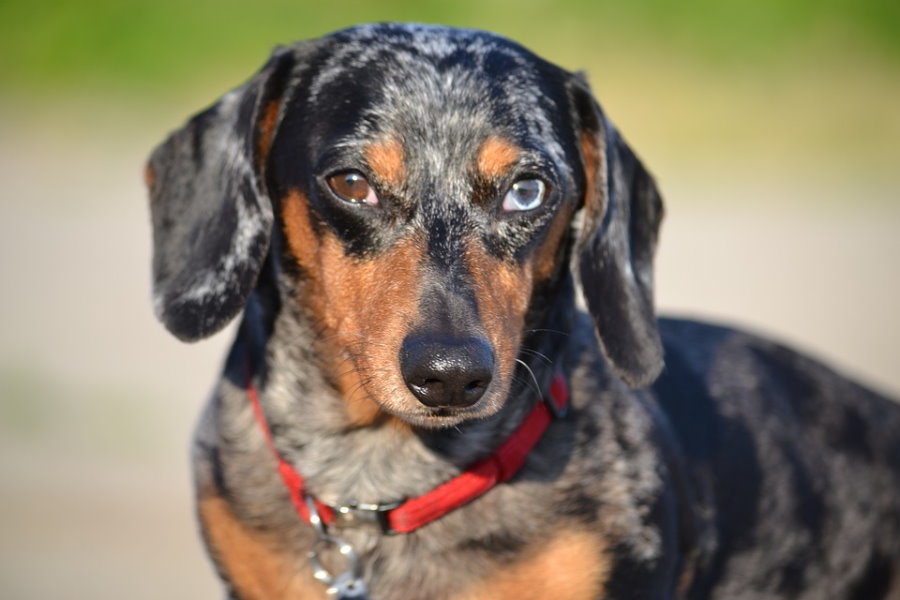
The Dapple Dachshund will have lighter patches of coloring (dappling) on top of the self color, creating a beautiful speckled, or patched, pattern. The size and quantity of the patches will vary from dachshund to dachshund. This same pattern is known as Merle in other dogs that are not quite fortunate enough to be a dachshund (Hey, all dogs are special, but here Dachshunds Rule!). If dappling occurs across the eyes, one or both eyes can have speckles of blue, or be completely blue. It is not unusual for a Dapple Dachshund to have one blue, or partially blue eye, and the other eye brown or hazel, depending upon the self color of the dachshund. The dapple pattern is very prominent in certain self colors, such as with the Black and Tan Dachshund, which presents with stunning silver-gray patches. So prominent is the dappling in Black and Tan Dachshunds, that they are often incorrectly called silver dachshunds, or silver dapples. In other self colors, the dappling can be very subtle. This is the case with Red Dachshunds, which may show dappling as a puppy, but can fade with age to be almost completely unnoticeable. Even if their is very little dappling on a dachshund, or the dappling fades, the dachshund should be registered as a dapple, because genetically, they are a dapple. This is an important bit of information to know, as breeding two dapples together can cause birth defects. See the Double Dapple section for more information.
Double Dapple
The Double Dapple Dachshund will usually have large areas of white over a dappled self color (See the Dapple section above for a description of dappling). Some Double Dapples appear almost completely white, with just a small amount of the dappled self color showing through. Ticking, which is small dots of color in the white areas, may or may not be present. Like the single Dapple, one or both eyes can be partially, or completely blue. A word of warning: No doubt that Double Dapple Dachshunds are beautiful and exotic looking, but breeding two Dapples together to get a Double Dapple can result in puppies that are deaf, blind, or both. In some cases, they can be born with one eye smaller than the other, or possibly missing an eye altogether. Some will be stillborn. Double Dapples can only come from breeding two Dapples together, although not all of the offspring will be Double Dapples, or even a single Dapple, for that matter. It is also possible that some Double Dapples can be born healthy, with no sight or hearing impairment. Even so, it’s the opinion of DachshundsRule.com, that it’s just not worth the risk. Ponderosa Pups has an excellent suggestion, if you like the Double Dapple pattern… consider a Dappled Piebald Dachshund, as the pattern is almost identical to that of the Double Dapple, and are free of birth defects.
Piebald

The Piebald Dachshund will have areas of the self color showing through a white background. The amount of white showing can vary from just a few small patches, to being almost completely white. Even on Piebalds with a lot of white showing, the self color will almost always show on the head, and the base of the tail. Ticking, which are small dots of color on the white, may or may not be present. True Piebalds will always have a white tail tip.
Photo Credit: See more of Lucy on PlaetDoxie’s Instagram Account
Brindle
A dachshund with a Brindle pattern will have dark tiger or zebra-like stripes over the self color. In darker colored dachshunds, like the Black and Tan, the Brindle pattern will only be visible in the lighter tan areas. Stripes are most often black, however, a Chocolate and Tan, or Chocolate and Cream Dachshund will have chocolate-colored brindling in the tan/cream areas, as they are unable to produce black pigment. In dachshunds, the Brindle pattern is considered somewhat rare.
Sable
The Sable pattern is somewhat rare and occurs almost exclusively in Red Long Haired Dachshunds. A Sable Dachshund has individual hairs that are banded with two colors. Typically the hair is red at the base of the strand, and black on the hair tips. From a distance they look almost completely black. Often, Long Haired Dachshunds with heavy black overlay are mistakenly call Sable. The black overlay is solid black hairs mixed in the with the tan, rather than the black and tan color appearing on single strands of hair.
Piebald Dapple
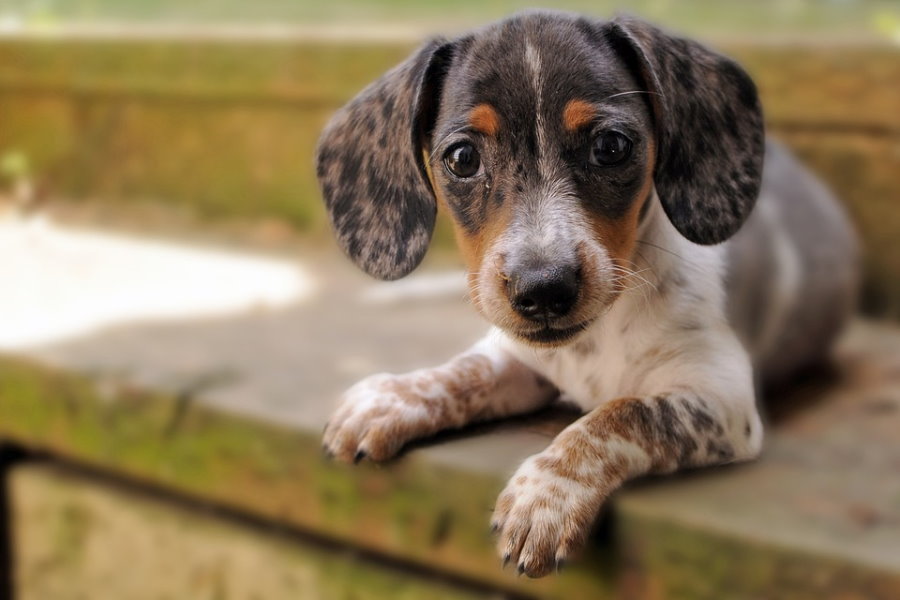
It is possible for a dachshund to have more than one coat pattern, such as the Piebald Dapple. A dachshund with this combined coat pattern will have characterictics of both overlays – patches of lighter coloring (dapple) and areas of white over the self-color (piebald).
Last updated: 07-01-2021

